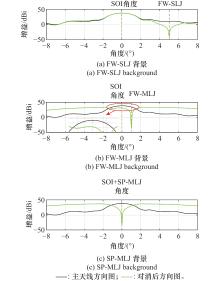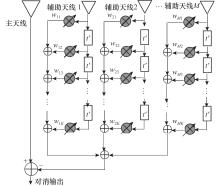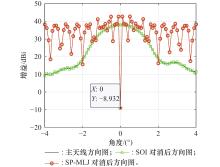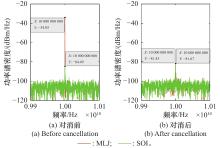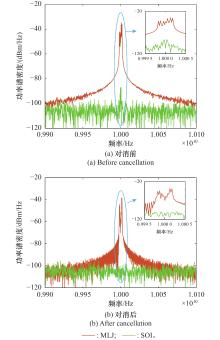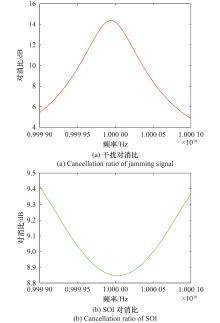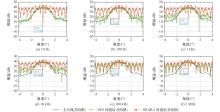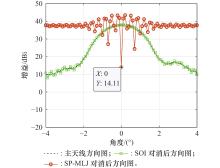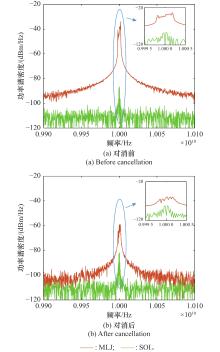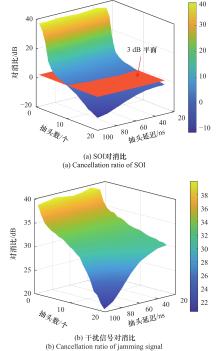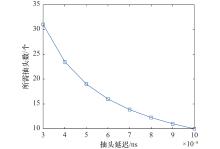Systems Engineering and Electronics ›› 2025, Vol. 47 ›› Issue (8): 2540-2548.doi: 10.12305/j.issn.1001-506X.2025.08.12
• Sensors and Signal Processing • Previous Articles
Analysis and optimization of bandwidth limitation for anti-mainlobe jamming method based on waveform coding
Juntian BO( ), Wantian WANG(
), Wantian WANG( ), Yaxing LI(
), Yaxing LI( ), Yunshuo ZHANG(
), Yunshuo ZHANG( ), Hengfeng WANG(
), Hengfeng WANG( ), Jiahao ZHANG(
), Jiahao ZHANG( ), Jin MENG(
), Jin MENG( )
)
- National Key Laboratory of Electromagnetic Energy,Naval University of Engineering,Wuhan 430033,China
-
Received:2024-04-03Online:2025-08-25Published:2025-09-04 -
Contact:Jiahao ZHANG E-mail:752284662@qq.com;18827086783@163.com;whhit173@hotmail.com;gudaowork@163.com;henvin999@163.com;jiahao.z@hotmail.com;mengjingemc@163.com
CLC Number:
Cite this article
Juntian BO, Wantian WANG, Yaxing LI, Yunshuo ZHANG, Hengfeng WANG, Jiahao ZHANG, Jin MENG. Analysis and optimization of bandwidth limitation for anti-mainlobe jamming method based on waveform coding[J]. Systems Engineering and Electronics, 2025, 47(8): 2540-2548.
share this article
| 1 |
KESKIN N, LIU H P. Practical considerations for electromagnetic interference suppression rate with spread spectrum clocking[J]. IEEE Electromagnetic Compatibility Magazine, 2016, 5 (2): 57- 60.
doi: 10.1109/MEMC.0.7543951 |
| 2 |
CHEN Z J, WANG L H, ZHANG Y H. Blockchain structure electromagnetic spectrum database in distributed cognitive radio monitoring system[J]. IEEE Trans. on Cognitive Communications and Networking, 2022, 8 (4): 1647- 1664.
doi: 10.1109/TCCN.2022.3201080 |
| 3 |
FAN Y P, CHEN Z J, SU T. Abnormal electromagnetic wave detection method before earthquake based on feature extraction of radio frequency I/Q signal[J]. IEEE Sensors Journal, 2023, 23 (11): 11796- 11805.
doi: 10.1109/JSEN.2023.3265078 |
| 4 |
KRISHNAMURTHY V, PATTANAYAK K, GOGINENI S, et al. Adversarial radar inference: inverse tracking, identifying cognition, and designing smart interference[J]. IEEE Trans. on Aerospace and Electronic Systems, 2021, 57 (4): 2067- 2081.
doi: 10.1109/TAES.2021.3090901 |
| 5 |
ZHANG W X, MA D, ZHAO Z K, et al. Design of cognitive jamming decision-making system against MFR based on reinforcement learning[J]. IEEE Trans. on Vehicular Technology, 2023, 72 (8): 10048- 10062.
doi: 10.1109/TVT.2023.3261318 |
| 6 | NIE G L, LIAO G S, ZENG C. Deceptive jamming suppression method for SAR via auxiliary-channel slow-time coding and change detection[J]. IEEE Geoscience and Remote Sensing Letters, 2022, 19, 4029105. |
| 7 |
LIAO Y, TANG H, WANG W Q, et al. A low sidelobe deceptive jamming suppression beamforming method with a frequency diverse array[J]. IEEE Trans. on Antennas and Propagation, 2022, 70 (6): 4884- 4889.
doi: 10.1109/TAP.2021.3138529 |
| 8 |
LIU F, MASOUROS C, LI A, et al. MIMO radar and cellular coexistence: a power-efficient approach enabled by interference exploitation[J]. IEEE Trans. on Signal Processing, 2018, 66 (14): 3681- 3695.
doi: 10.1109/TSP.2018.2833813 |
| 9 |
ROSENBERG L K, GRAY D A. Constrained fast-time STAP for interference suppression in multichannel SAR[J]. IEEE Trans. on Aerospace and Electronic Systems, 2013, 49 (3): 1792- 1805.
doi: 10.1109/TAES.2013.6558020 |
| 10 |
CAROTENUTO V, ORLANDO D, FARINA A. Interference covariance matrix structure classification in heterogeneous environment[J]. IEEE Signal Processing Letters, 2019, 26 (10): 1491- 1495.
doi: 10.1109/LSP.2019.2936101 |
| 11 |
CHENG S H, SUN X L, CAI Y H et al. A joint azimuth multichannel cancellation(JAMC) antibarrage jamming scheme for spaceborne SAR[J]. IEEE Journal of Selected Topics in Applied Earth Observations and Remote Sensing, 2022, 15, 9913- 9926.
doi: 10.1109/JSTARS.2022.3221402 |
| 12 |
张亮, 王国宏, 张翔宇, 等. 快慢时间域联合处理抑制C&I干扰[J]. 系统工程与电子技术, 2020, 42 (6): 1274- 1282.
doi: 10.3969/j.issn.1001-506X.2020.06.10 |
|
ZHANG L, WANG G H, ZHANG X Y, et al. Fast-slow time domain joint processing suppressing C&I jamming[J]. Systems Engineering and Electronics, 2020, 42 (6): 1274- 1282.
doi: 10.3969/j.issn.1001-506X.2020.06.10 |
|
| 13 | 李欣, 王春阳, 原慧, 等. 基于干扰重构和峭度最大化的SMSP干扰抑制方法[J]. 北京航空航天大学学报, 2018, 44 (6): 1176- 1184. |
| LI X, WANG C Y, YUAN H, et al. SMSP jamming suppression method based on jamming reconstruction and kurtosis maximum[J]. Journal of Beijing University of Aeronautics and Astronautics, 2018, 44 (6): 1176- 1184. | |
| 14 | ZHOU C, LIU Q H, CHEN X L. Parameter estimation and suppression for DRFM-based interrupted sampling repeater jammer[J]. IET Radar, Sonar & Navigation, 2017, 12(1): 56−63. |
| 15 | 张嘉毫, 李伟, 王万田, 等. 阵列自由度欠定条件下雷达干扰对消方法及性能分析[J]. 系统工程与电子技术, 2024, 46 (11): 3639- 3647. |
| ZHANG J H, LI W, WANG W T, et al. Method and analysis of radar interference cancellation on condition of incomplete antenna array freedom[J]. Systems Engineering and Electronics, 2024, 46 (11): 3639- 3647. | |
| 16 |
蒋伊琳, 王林森, 李金鑫. 基于深度神经网络的收发同时系统中自干扰数字对消算法[J]. 电子与信息学报, 2022, 44 (12): 4229- 4237.
doi: 10.11999/JEIT211103 |
|
JIANG Y L, WANG L S, LI J X. Self-interference digital cancellation algorithm in simultaneous transceiver system based on deep neural network[J]. Journal of Electronics & Information Technology, 2022, 44 (12): 4229- 4237.
doi: 10.11999/JEIT211103 |
|
| 17 |
ZHANG J H, LI W, GAO H Z, et al. , Heterogeneous dispersed antenna array design for noncooperative interference cancellation[J]. IEEE Trans. on Antennas and Propagation, 2024, 72 (6): 5021- 5032.
doi: 10.1109/TAP.2024.3391896 |
| 18 |
ZHANG Y J, HUO W B, HUANG Y L, et al. Jamming policy generation via heuristic programming reinforcement learning[J]. IEEE Trans. on Aerospace and Electronic Systems, 2023, 59 (6): 8782- 8799.
doi: 10.1109/TAES.2023.3312231 |
| 19 |
SHA M H, MAO E K, ZHANG K. Polarization-space joint mainlobe jamming countermeasure technique based on divided dimensions[J]. Journal of Systems Engineering and Electronics, 2022, 33 (3): 594- 599.
doi: 10.23919/JSEE.2022.000057 |
| 20 |
CHEN X Z, SHU T, YU K B, et al. Implementation of an adaptive wideband digital array radar processor using subbanding for enhanced jamming cancellation[J]. IEEE Trans. on Aerospace and Electronic Systems, 2021, 57 (2): 762- 775.
doi: 10.1109/TAES.2020.3042764 |
| 21 |
VOOK F W, COMPTON R T. Bandwidth performance of linear adaptive arrays with tapped delay-line processing[J]. IEEE Trans. on Aerospace and Electronic Systems, 1992, 28 (3): 901- 908.
doi: 10.1109/7.256314 |
| 22 |
MARTI G, STUDER C. Single-antenna jammers in MIMO-OFDM can resemble multi-antenna jammers[J]. IEEE Communications Letters, 2023, 27 (11): 3103- 3107.
doi: 10.1109/LCOMM.2023.3319818 |
| 23 | BIGNOTTE E M, UNTERHUBER P, GOMEZ A A, et al. Measurement based tapped delay line model for train-to-train communications[J] IEEE Trans. on Vehicular Technology, 2023, 72(4): 4168−4181. |
| 24 |
WANG M C, YANG W W, LU X B, et al. Channel inversion power control aided covert communications in uplink NOMA systems[J]. IEEE Wireless Communications Letters, 2022, 11 (4): 871- 875.
doi: 10.1109/LWC.2022.3149279 |
| 25 |
KISHORE T R, RAO K D. Automatic intrapulse modulation classification of advanced LPI radar waveforms[J]. IEEE Trans. on Aerospace and Electronic Systems, 2017, 53 (2): 901- 914.
doi: 10.1109/TAES.2017.2667142 |
| 26 |
GOU W L, WANG L, LIU Y F, et al. Generation of phase-coded LFM signals based on Fourier domain mode-locked optoelectronic oscillator[J]. Journal of Lightwave Technology, 2023, 41 (19): 6142- 6148.
doi: 10.1109/JLT.2023.3282992 |
| 27 |
DONG H, DAI F Z, ZHANG J, et al. HRRPs reconstruction of multiple high-speed targets with large time-bandwidth product LFM waveform based on efficient SBL[J]. IEEE Trans. on Aerospace and Electronic Systems, 2024, 60 (4): 5322- 5339.
doi: 10.1109/TAES.2024.3390650 |
| 28 |
HUANG Q, WEI S P, ZHANG L. Robust adaptive time-frequency filtering for frequency shift jamming suppression[J]. IEEE Trans. on Aerospace and Electronic Systems, 2023, 59 (6): 7963- 7976.
doi: 10.1109/TAES.2023.3297559 |
| 29 | 秦焕丁, 孟进, 何方敏, 等. 多抽头结构的宽带射频干扰对消及优化设计[J]. 系统工程与电子技术, 2023, 45 (9): 2681- 2689. |
| QING H D, MENG J, HE F M, et al. Optimization design of wideband RF interference cancellation based on multi-tap structure[J]. Systems Engineering and Electronics, 2023, 45 (9): 2681- 2689. | |
| 30 |
GAO C C, THE K C, LIU A. Piecewise nonlinear frequency modulation waveform for MIMO radar[J]. IEEE Journal of Selected Topics in Signal Processing, 2017, 11 (2): 379- 390.
doi: 10.1109/JSTSP.2016.2616108 |
| [1] | Kuan YANG, Xiaojian XU. Active polarimetric calibration technique based on parameter extrapolation for ultrawide-band radar [J]. Systems Engineering and Electronics, 2025, 47(8): 2498-2510. |
| [2] | Yingcong LUO, Lei ZHANG, Shaopeng WEI, Zhichao MENG. Joint design algorithm using chaotic waveform and mismatched filter for low sidelobe near mainlobe region [J]. Systems Engineering and Electronics, 2025, 47(8): 2511-2518. |
| [3] | Weihong FU, Wenhong PENG, Naian LIU. SAR image small target detection method with hybrid attention optimization [J]. Systems Engineering and Electronics, 2025, 47(8): 2519-2526. |
| [4] | Kang NI, Wenjie JIA, Minrui ZOU, Zhizhong ZHENG. SAR object detection based on dynamic aggregation network [J]. Systems Engineering and Electronics, 2025, 47(8): 2527-2539. |
| [5] | Chen TIAN, Yangyang GUAN, Chunliang DAI, Yu MAO. LPI based line formation design of multiple receivers for single-transmitter multiple-receiver cooperative radar system [J]. Systems Engineering and Electronics, 2025, 47(7): 2176-2184. |
| [6] | Kai ZHOU, Chao LI, Kun LI, Xinfeng CUI, Huiwei YAO, Dongdong CHEN. Design of waveform and mismatched filter for suppressing shift-frequency interrupted sampling repeater jamming [J]. Systems Engineering and Electronics, 2025, 47(7): 2194-2204. |
| [7] | Pengcheng ZHANG, Bo PENG, Mingxing FANG. An analysis of jamming method based on the correlation characteristics of modulation sequences [J]. Systems Engineering and Electronics, 2025, 47(6): 1729-1738. |
| [8] | Fengzhuo HUANG, Dong FENG, Yangsheng HUA, Xiaotao HUANG. An improved holographic SAR phase gradient autofocus algorithm [J]. Systems Engineering and Electronics, 2025, 47(6): 1786-1795. |
| [9] | Xinzheng ZHANG, Mengke YAN, Xiaolin ZHU. Noise pseudo-label tolerant semi-supervised SAR target recognition [J]. Systems Engineering and Electronics, 2025, 47(6): 1796-1805. |
| [10] | Qingyun KAN, Jingwei XU, Guisheng LIAO, Weiwei WANG. Clutter modeling and analysis for air-space bistatic radar [J]. Systems Engineering and Electronics, 2025, 47(6): 1806-1815. |
| [11] | Junhao JIA, Xuebin CHEN, Zhangfeng LI, Chunmao YE. ISAR imaging and detection method for space group target [J]. Systems Engineering and Electronics, 2025, 47(6): 1843-1854. |
| [12] | Zhikang LIN, Longfei SHI, Jialei LIU, Jiazhi MA. Scintillation detection scheduling method of netted radar based on deep Q-learning [J]. Systems Engineering and Electronics, 2025, 47(5): 1443-1452. |
| [13] | Zhijie JIANG, Heng SONG, Nan HU, Lanxi DUAN, Ping CAO. Target recognition and classification algorithm of MMW radar in tunnel [J]. Systems Engineering and Electronics, 2025, 47(5): 1453-1460. |
| [14] | Xiangtian MENG, Zhehan JING, Bingxia CAO, Minghui SHA, Yingshen ZHU, Fenggang YAN. Super-resolution target localization method based on multi-dimensional parameter spectrum reconstruction of FDA-MIMO radar [J]. Systems Engineering and Electronics, 2025, 47(5): 1461-1468. |
| [15] | Ning LIU, Fangfang LI, Xinwu LI, Wen HONG. 3D reconstruction of high-rise buildings from SAR combined with footprint and phase information [J]. Systems Engineering and Electronics, 2025, 47(5): 1469-1486. |
| Viewed | ||||||
|
Full text |
|
|||||
|
Abstract |
|
|||||
